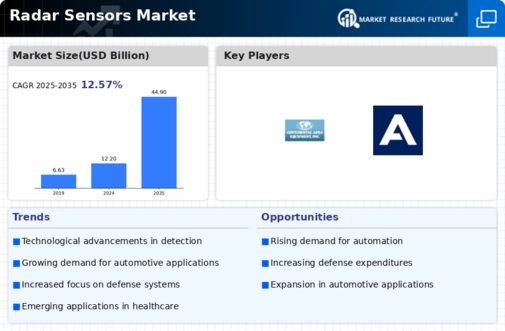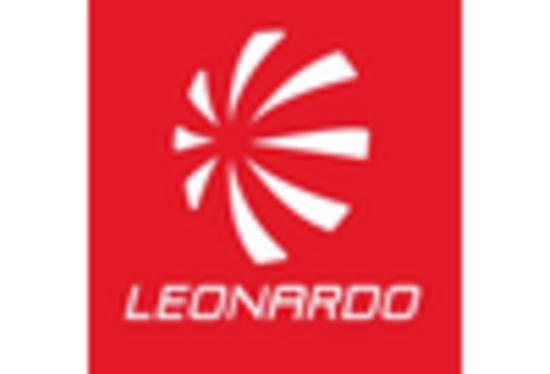Market Share
Introduction: Navigating the Competitive Landscape of Radar Sensors
The radar sensors market is experiencing a seismic shift driven by rapid technology adoption, evolving regulatory frameworks, and heightened consumer expectations for safety and efficiency. Key players, including OEMs, IT integrators, infrastructure providers, and innovative AI startups, are fiercely competing for market leadership by leveraging advanced capabilities such as AI-based analytics, automation, and IoT integration. These technology-driven differentiators are not only enhancing product performance but also reshaping customer engagement strategies, thereby influencing market positioning. As regional growth opportunities emerge, particularly in North America and Asia-Pacific, strategic deployment trends are increasingly focused on integrating green infrastructure and biometrics to meet sustainability goals. Executives must remain vigilant to these dynamics, as the competitive momentum in the radar sensors market is set to redefine industry standards and consumer expectations in the coming years.
Competitive Positioning
Full-Suite Integrators
These vendors provide comprehensive radar solutions, integrating hardware and software for diverse applications.
| Vendor | Competitive Edge | Solution Focus | Regional Focus |
|---|---|---|---|
| Lockheed Martin Corporation | Advanced defense technology expertise | Military and aerospace radar systems | North America, Europe |
| Raytheon Company | Strong focus on defense and security | Defense radar systems | North America, Asia |
| Northrop Grumman Corporation | Innovative aerospace and defense solutions | Advanced radar systems | North America, Europe |
| Saab AB | Expertise in military and civil radar | Defense and surveillance radar | Europe, Asia |
Specialized Technology Vendors
These companies focus on specific radar technologies, offering niche solutions for various industries.
| Vendor | Competitive Edge | Solution Focus | Regional Focus |
|---|---|---|---|
| Robert Bosch GmbH | Strong automotive sensor integration | Automotive radar systems | Global |
| Denso Corporation | Leading automotive technology provider | Automotive radar solutions | Asia, North America |
| Infineon Technologies AG | Expertise in semiconductor technology | Radar chipsets and components | Global |
| NXP Semiconductors NV | Innovative automotive solutions | Automotive radar technology | Global |
| Omniradar BV | Focus on innovative radar solutions | Automotive and industrial radar | Europe |
Infrastructure & Equipment Providers
These vendors supply essential radar infrastructure and equipment, supporting various applications.
| Vendor | Competitive Edge | Solution Focus | Regional Focus |
|---|---|---|---|
| Hitachi Ltd | Diverse technology portfolio | Industrial and automotive radar | Asia, North America |
| Continental AG | Strong automotive component expertise | Automotive radar systems | Global |
| ZF Friedrichshafen AG | Expertise in vehicle safety technologies | Automotive radar solutions | Global |
| Airbus Group | Leading aerospace and defense capabilities | Aerospace radar systems | Global |
Emerging Players & Regional Champions
- Adept Technology (USA): Specializes in advanced automotive radar sensors for autonomous vehicles, recently secured a contract with a major automotive manufacturer for next-gen vehicle safety systems, challenging established players like Bosch and Continental by offering more cost-effective solutions.
- Sierra Wireless (Canada): Focuses on IoT radar sensors for smart city applications, recently implemented a project in partnership with a municipal government to enhance traffic management, complementing traditional vendors by integrating connectivity features.
- Rohde & Schwarz (Germany): Offers high-frequency radar sensors for defense applications, recently awarded a contract for a military radar system upgrade, positioning itself as a strong competitor to established defense contractors by providing innovative technology.
- Innovative Radar Solutions (India): Develops low-cost radar sensors for agricultural monitoring, recently partnered with local farmers' cooperatives to deploy their technology, challenging larger agricultural tech firms by focusing on affordability and local needs.
Regional Trends: In 2024, there is a notable increase in the adoption of radar sensors across various sectors, particularly in North America and Europe, driven by advancements in autonomous vehicle technology and smart city initiatives. Emerging players are focusing on niche applications, such as agricultural monitoring and IoT integration, which allows them to carve out market segments that established vendors may overlook. Additionally, there is a growing trend towards localization of manufacturing and solutions to meet specific regional needs, enhancing the competitive landscape.
Collaborations & M&A Movements
- Lockheed Martin and Northrop Grumman entered a partnership to develop advanced radar sensor technologies for military applications, aiming to enhance defense capabilities and strengthen their competitive positioning in the defense sector.
- Raytheon Technologies acquired the radar division of a smaller tech firm to bolster its portfolio in next-generation radar systems, thereby increasing its market share in the aerospace and defense industry.
- Honeywell and Siemens formed a collaboration to integrate radar sensor technology into smart building solutions, focusing on improving safety and operational efficiency in urban environments.
Competitive Summary Table
| Capability | Leading Players | Remarks |
|---|---|---|
| Biometric Self-Boarding | Honeywell, Thales | Honeywell has implemented biometric self-boarding solutions at major airports, enhancing passenger flow and reducing wait times. Thales offers advanced facial recognition technology that integrates seamlessly with existing airport systems, demonstrating high accuracy and speed. |
| AI-Powered Ops Mgmt | Siemens, Raytheon | Siemens utilizes AI algorithms to optimize radar sensor data for operational management, improving decision-making processes. Raytheon has developed AI-driven analytics tools that enhance situational awareness and operational efficiency in security applications. |
| Border Control | L3Harris, Northrop Grumman | L3Harris provides advanced radar systems for border surveillance, offering real-time data processing capabilities. Northrop Grumman's radar solutions are known for their long-range detection and integration with other security systems, enhancing border security measures. |
| Sustainability | Bosch, Teledyne | Bosch focuses on developing energy-efficient radar sensors that reduce environmental impact, with case studies showing significant energy savings in operational settings. Teledyne emphasizes sustainable manufacturing processes and materials in their radar sensor production. |
| Passenger Experience | Aviat Networks, Zebra Technologies | Aviat Networks enhances passenger experience through real-time location tracking and communication systems that utilize radar technology. Zebra Technologies integrates radar sensors into their mobile solutions, improving service delivery and operational efficiency in airports. |
Conclusion: Navigating the Radar Sensors Landscape
As we approach 2024, the radar sensors market is characterized by intense competitive dynamics and notable fragmentation, with both legacy and emerging players vying for market share. Regional trends indicate a growing demand in North America and Asia-Pacific, driven by advancements in automotive safety and smart city initiatives. Vendors must strategically position themselves by leveraging capabilities in AI, automation, sustainability, and flexibility to gain a competitive edge. Legacy players are focusing on enhancing their technological offerings, while emerging companies are innovating with agile solutions that cater to niche applications. The ability to integrate advanced analytics and sustainable practices will be crucial for leadership in this evolving landscape, making it imperative for decision-makers to align their strategies accordingly.









Leave a Comment